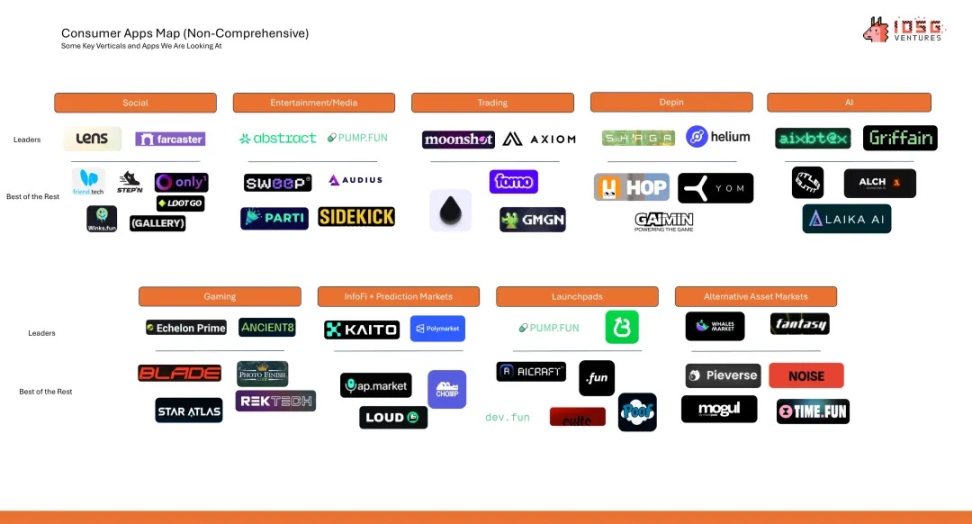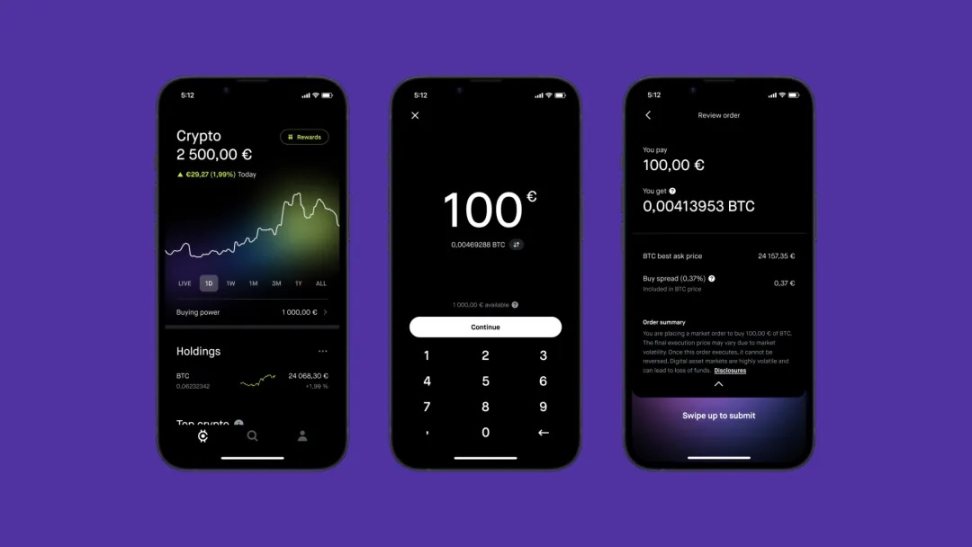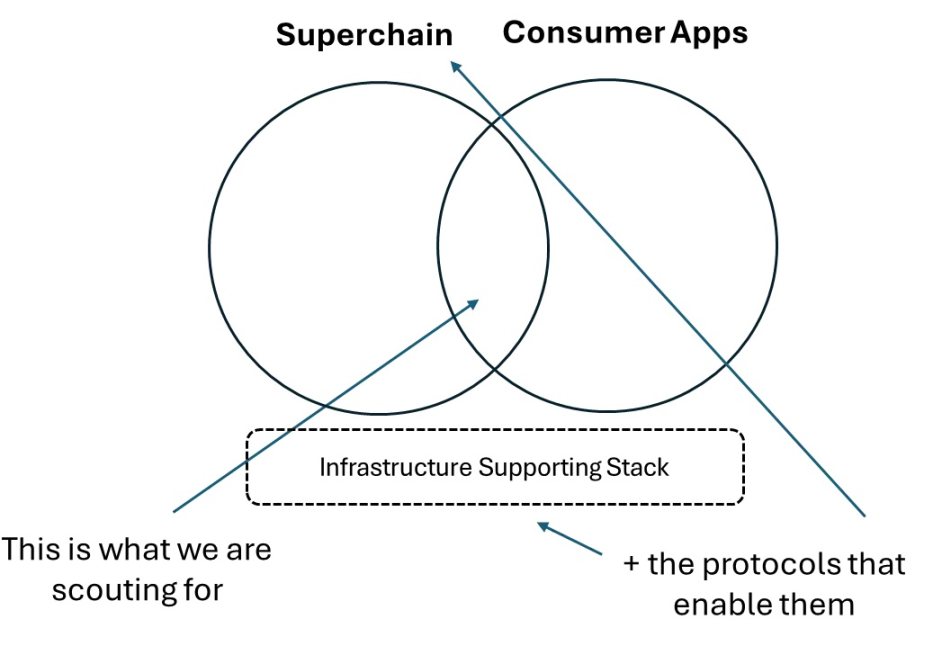Written by: Max Wong @IOSG
TL;DR
Infrastructure has become saturated; consumer applications are the next frontier. After years of pouring funds into new L1s, Roll-ups, and development tools, the marginal returns on technology have become negligible, and users do not automatically flock in just because "the technology is good enough." What creates value now is attention, not architecture.
Liquidity is stagnant, and retail investors are absent. The total market cap of stablecoins is only about 25% higher than the historical peak in 2021, with recent increments mainly coming from institutions purchasing BTC/ETH for their balance sheets, rather than speculative capital circulating within the ecosystem.
Core Assertions
Friendly regulatory policies will unlock a "second wave" of development. Clearer U.S. policies (Trump administration, stablecoin legislation) expand the Total Addressable Market (TAM) and attract Web2 users who care only about tangible applications, not underlying technology architecture.
The narrative market rewards real usage. Projects with substantial revenue and Product-Market Fit (PMF) — such as Hyperliquid (approximately $900 million ARR), Pump.fun (approximately $500 million ARR), Polymarket (approximately $12 billion in transaction volume) — far outperform infrastructure projects that have high funding but lack users (Berachain, SEI, Story Protocol).
Consumer tracks (crypto-native) that have reached PMF:
- Trading / perpetual contracts (Hyperliquid, Axiom)
- Launchpad / meme coin factories (Pump.fun, BelieveApp)
- InfoFi and prediction markets (Polymarket, Kaito)
Next wave of rising tracks (Web2 coding):
- One-stop deposit/withdrawal + DeFi super applications — integrating wallets, banking, yield, and trading (Robinhood-like experience but without ads).
- Entertainment/social platforms that replace advertising with on-chain monetization (exchanges, betting, prize pools, creator tokens), optimizing UX and improving creator earnings.
AI and gaming are still in the pre-PMF stage. Consumer AI needs safer account abstractions and infrastructure; Web3 gaming is troubled by "wool hat" economies. A breakout will only occur after a game-centric blockchain game, rather than one focused on crypto elements, explodes.
Superchain theory. Activity is positively concentrated on a few consumer-friendly chains (Solana, Hyperliquid, Monad, MegaETH). Killer applications from these ecosystems and the infrastructure that directly supports them should be selected.
Investment perspective on consumer applications:
- Distribution and execution > pure technology (network effects, viral loops, branding).
- UX, speed, liquidity, and narrative fit determine success or failure.
- Evaluate as "businesses" rather than "protocols": real revenue, scalable models, clear industry dominance paths.
Bottom line: Pure infrastructure trading is unlikely to replicate the valuation multiples of 2021. In the next five years, excess returns will come from transforming crypto infrastructure into consumer applications that millions of Web2 users experience daily.
Introduction
In the past, the industry focused heavily on technology/infrastructure, concentrating on building "tracks" — new Layer-1s, scaling layers, developer tools, and security primitives. The driving force was the industry creed of "technology is king": as long as the technology is good enough and innovative, users will naturally come. However, this is not the case. Look at projects like Berachain, SEI, and Story Protocol, which have outrageous funding valuations but are touted as "the next big thing."
In this cycle, as consumer application projects take the spotlight, discussions have clearly shifted to "what are these tracks actually used for." When core infrastructure reaches a "sufficient" level of maturity and marginal improvements begin to diminish, talent and capital start chasing consumer-facing applications/products — social, gaming, creators, business scenarios — to demonstrate the value of blockchain to retail and everyday users. The consumer application market is essentially an attention economy, which also makes the entire crypto market a battleground for narratives and attention.
This insight report will explore:
Overall market background
Types of consumer applications in the market
a. Tracks that have reached PMF
b. Tracks that can upgrade through crypto tracks and ultimately reach PMF
Framework and investment thesis for consumer applications — how can institutions identify winners?
Narrative — Why Now?
This cycle lacks the retail FOMO and NFT/Alt hype seen in 2021, and the tightening macro environment has restricted capital inflows from VCs and institutions, leading to a "stagflation" situation for new liquidity growth.

▲ Stablecoin Market Cap Trend
As shown in the chart above, the total market cap of stablecoins grew about 5 times from 2021 to 2022, while this round (second half of 2023 - 2025) has only seen a 2-fold increase. At first glance, this seems like organic and healthy steady growth, but it is misleading: the current market cap is only about 25% higher than the peak in 2021, which is low-speed for any industry over a four-year dimension. This is still under the backdrop of stablecoins receiving the clearest regulatory tailwinds and a strong pro-coin president emerging.
The growth rate of capital inflows has significantly slowed, and it only began after Trump was elected in January 2025. To date, new capital is not speculative or truly "fresh water"; it is more about institutions incorporating BTC/ETH into their balance sheets and governments and enterprises expanding stablecoin payments. Liquidity is not driven by market interest in new products/solutions but rather by favorable regulations; this capital is non-speculative and will not directly inject into the secondary market. This is not free capital, nor is it retail-driven, so even if prices reach new highs, the industry has not rekindled the 2021 frenzy.
Overall, this can be likened to the search for the next growth direction after the 2001 .com bubble — this time, the direction will be consumer applications. Past growth was also driven by consumer applications, but the products were NFTs and altcoins, not applications.
Core Assertions
In the next 5 years, the crypto market will welcome a second wave of growth driven by Web2/retail investors
- Clearer crypto policies from the Trump administration open the green light for founders.
- Stablecoin legislation significantly expands the TAM for all crypto applications.
- The previous liquidity bottleneck was due to a lack of clear frameworks and significant market island effects; now, favorable stablecoin regulations benefit liquidity.
- Strong positive sentiment at the political level has a greater impact on consumer applications than on infrastructure, as consumer applications can attract a large number of Web2 users.
- Web2 users only care about the application layer they can directly interact with and products that bring them value — they want a "Robinhood" for Web3, not "crypto AWS."
- Robinhood
- Google/YouTube
- Snapchat
- ChatGPT
Market Maturity → Focus on Real Users + Revenue + PMF > Infrastructure + Technology
- In the narrative market, capital continues to flow toward projects with real revenue and real PMF, and the vast majority are consumer applications because they have real users.
- Hyperliquid
- Pump.fun
- Polymarket
- Significance: Technology is important, but just having good technology does not attract users; it must be implemented → the easiest path is consumer applications.
- Method: Projects with a unified extreme UX + value capture mechanisms will attract users. Users do not care if the technology is slightly better unless they can "feel" it.
- Builders are shifting from "technology is king" from 2019-2023 to "user-centric." Only chains with actual demand, rather than those relying solely on subsidies for ecosystems or tools, will attract developers.
- In the past, the market made developers write extensions for Firefox for subsidies, rather than acquiring real users on Chrome.
- Typical counterexample: Cardano
Web2 has always been an attention economy (distribution > technology); after the deep integration of Web3 and Web2, it will be the same — B2C applications will expand the overall market
- Viral spread and attention are the keys to success → consumer applications are the easiest to achieve.
- Because network effects can be easily embedded in consumer applications → such as binding Twitter and receiving protocol rewards for posting (Loudio, Kaito).
- Therefore, consumer application content can easily generate → easy viral spread, occupying mental space.
- B2C applications can also easily create topics through user behavior, incentives, or communities (Pump.fun vs Hyperliquid).
- Viral spread brings attention, and attention brings users → viral applications will attract new retail investors and expand the market.
Types of Consumer Applications in the Market

Vertical Tracks That Have Reached PMF – Crypto Coded
Trading
- Hyperliquid: approximately $900 million ARR; funding $0
- Axiom: approximately $120 million ARR; funding $21 million
Launchpad
- Pump.fun: approximately $500 million ARR; funding $0
- BelieveApp: annual fees approximately $60 million; funding $0
InfoFi + Prediction Markets
- Polymarket: annual transaction volume approximately $12 billion (0% fee rate); funding $0
- Kaito: approximately $33 million ARR; funding $10.8 million
Such track projects should be given priority attention.
Comparison:
- Berachain: only $165,000 in fees since launch; funding $142 million; down 85%+ from ATH.
- SEI: only $68,000 in annual fees; funding $95 million; down 75%+.
- Story Protocol: only $24,000 in fees since launch; funding $134 million; down 60%.
Pure technology/infrastructure lacking real use cases is no longer a viable path. Institutions can no longer rely on such targets to replicate the excess returns of 2021.
From these platforms, it can be seen that most are more Web3 native, aligning with their crypto functionality. However, there are also traditional consumer tracks (as discussed below) that have been disrupted by crypto tracks and are moving towards the mainstream.
Vertical Tracks That Can Upgrade Through "Crypto Technology" and Ultimately Reach PMF – Web2 Coded
Web2⇄Web3 Deposit/Withdrawal + DeFi Frontend
As Web2 users continue to flow into Web3, it is time for one or two mainstream solutions that everyone uses to facilitate deposits/withdrawals and access DeFi. Currently, the market is highly fragmented, and user processes are cumbersome.
Current Pain Points
- Jumping through hoops to go on-chain: 75-80% of first-time coin buyers still buy coins on centralized exchanges (Binance, Coinbase) before transferring to self-custody wallets or DeFi protocols, resulting in 2 KYC processes, 2 sets of fees, and at least 1 cross-chain bridge.
- Withdrawal difficulties: U.S. licensed CEXs can freeze fiat for 24-72 hours; EU banks increasingly mark outbound SEPA transfers as "high risk."
- High fees: Deposit spreads range from ~0.8% (ACH) to 4-5% (credit card); stablecoin withdrawal fees fluctuate between 0.1-7% depending on the region and amount.
- Lack of aggregated yield solutions: There is currently no one-stop DeFi module that allows users to concentrate their yield stacks.
Payment Giants Are Making Moves
- PayPal now allows U.S. users to withdraw PYUSD directly to Ethereum and Solana and return to any debit card within 30 seconds (fees 0.4-1%).
- Stripe will open its "crypto withdrawal" API to all platforms in April 2025, allowing instant USDC withdrawals to local channels in 45 countries.
- MoonPay processed $18.6 billion in transaction volume for 14 million users last year, achieving 123% year-over-year growth due to the addition of instant withdrawal services covering over 160 countries.
PMF Profile
A global super application where users can seamlessly deposit/withdraw, with a clean interface, and access all DeFi functionalities on the same platform.
- A single platform account holds funds, seamlessly connecting bank accounts and crypto wallets.
- Only large amounts require KYC.
- No high fees or withdrawal delays.
- Similar to a savings account but priced in crypto.
- Yield aggregator, integrated with mainstream lending protocols (Aave, Kamino, Morpho) and staking.
- Covers mainstream spot/perpetual trading interfaces.

Currently, the closest to this North Star is Robinhood: an ultra-simple UI/UX, combined with bank and wallet integration; it may be the frontrunner in this track.
Entertainment / Media / Social
Current content platforms (YouTube, Twitch, Facebook) primarily rely on capturing user attention and selling it to advertisers through display ads. However, this conversion chain is inherently inefficient, losing potential customers at multiple stages of the funnel. More critically, display ads "forcefully insert" content, naturally damaging the UX.
The crypto paradigm can fundamentally rewrite and optimize the structure of traditional Web2 entertainment platforms.
Platform Layer Unlocks:
- Introduce and generate new revenue streams.
- DEX integration — exchange fees.
- Creator-linked tokens.
- Live event betting.
- Prize pools.
- Airdrops to users.
- Ad-free, enhancing user retention.
- No longer reliant on external stakeholders.
- New revenue-sharing models with creators.
- Revenue sharing from exchange fees.
- Revenue sharing from event fees.
In this new paradigm, the platform itself becomes a distribution channel rather than a monetization product. There are precedents in Web2: Twitch → Amazon, Kick → Stake, Twitter → membership subscriptions + GrokAI; early forms are also seen in Web3, such as Parti and Pump.fun live streams.
User Layer Unlocks
- Ad-free brings better UX.
- Users benefit through prize pools and airdrops for supporting/watching their favorite creators.
- Token dividends.
Creator Layer Unlocks
- Contribution-based revenue models; more transparent and fair.
- Revenue sharing from exchange fees.
- Revenue sharing from event fees.
- Creator tokens enable direct value flow from fans to creators.
- Ad-free enhances user retention.
- Platform models inherently drive user growth, benefiting creators.
Why Not AI or Gaming?
Currently, AI consumer applications are still in their early stages. A true explosion will only occur when applications that can genuinely achieve "one-click DeFi/account management" emerge; the current infrastructure is still lacking in safety and feasibility.
In gaming, blockchain games struggle to break out of their niche, as core users are often "Farmers" chasing money rather than gaming enjoyment, leading to low retention. However, in the future, there may be games that use crypto paradigms in the background (such as economies and item systems), while players/developers still focus on playability — if CSGO had used on-chain economics, it might have been very successful.
In this regard, there are already some successful cases of mini-games utilizing crypto mechanisms (Freysa, DFK, Axie).
Arguments and Framework
Overall viewpoint: Market maturity → Reduced fragmentation between chains → A few "super chains" emerge victorious → Institutions should bet on the next generation of consumer applications and their supporting infrastructure on these super chains.
This trend is already happening, with activity concentrating on a few chains rather than being dispersed across over 100 L2s.

Here, "super chains" refer to consumer-centric chains that optimize speed and experience, such as Solana, Hyperliquid, Monad, and MegaETH.
Analogy:
- Super chains: iOS, Android
- Applications: Instagram, Cash App, Robinhood
- Supporting stack: AWS, Azure, Google Cloud
As mentioned earlier, consumer applications can be divided into two key categories:
- Web2 native: Applications that first attract Web2 users, unlocking new behaviors using crypto paradigms — attention should be paid to products that seamlessly integrate crypto in the backend without claiming to be "crypto applications" (like Polymarket).
- Web3 native: Verified determinants are better UX + fast interfaces + sufficient liquidity + one-stop solutions (breaking fragmentation). The new generation of Web3 users values UX > yield or technology, only caring about the latter two after surpassing a certain threshold. Teams and applications that understand this should receive valuation premiums.
Additionally, the following elements are generally required:

Conclusion
Consumer investment targets do not need to rely entirely on differentiated value propositions (though they can). Snapchat was not a technological revolution but rather a recombination of existing technologies (chat modules, camera AIO) to create new unlocks. Therefore, evaluating consumer targets from a traditional infrastructure perspective is biased; institutions should consider whether the project can become a good business and ultimately generate returns for the fund.
To this end, the following should be assessed:
- Distribution capability outweighs the product itself — can they reach users?
- Do they effectively reorganize existing modules to create a completely new experience?
Funds can no longer rely on pure infrastructure to drive returns. This is not to say that infrastructure is unimportant, but they must possess real appeal and use cases in a narrative-driven market, rather than value propositions that no one cares about. Overall, regarding consumer targets, most investors are overly "right-biased" — too literally adhering to "first principles," while true winners often rely on better branding and UX — these traits are implicit yet crucial.
免责声明:本文章仅代表作者个人观点,不代表本平台的立场和观点。本文章仅供信息分享,不构成对任何人的任何投资建议。用户与作者之间的任何争议,与本平台无关。如网页中刊载的文章或图片涉及侵权,请提供相关的权利证明和身份证明发送邮件到support@aicoin.com,本平台相关工作人员将会进行核查。



